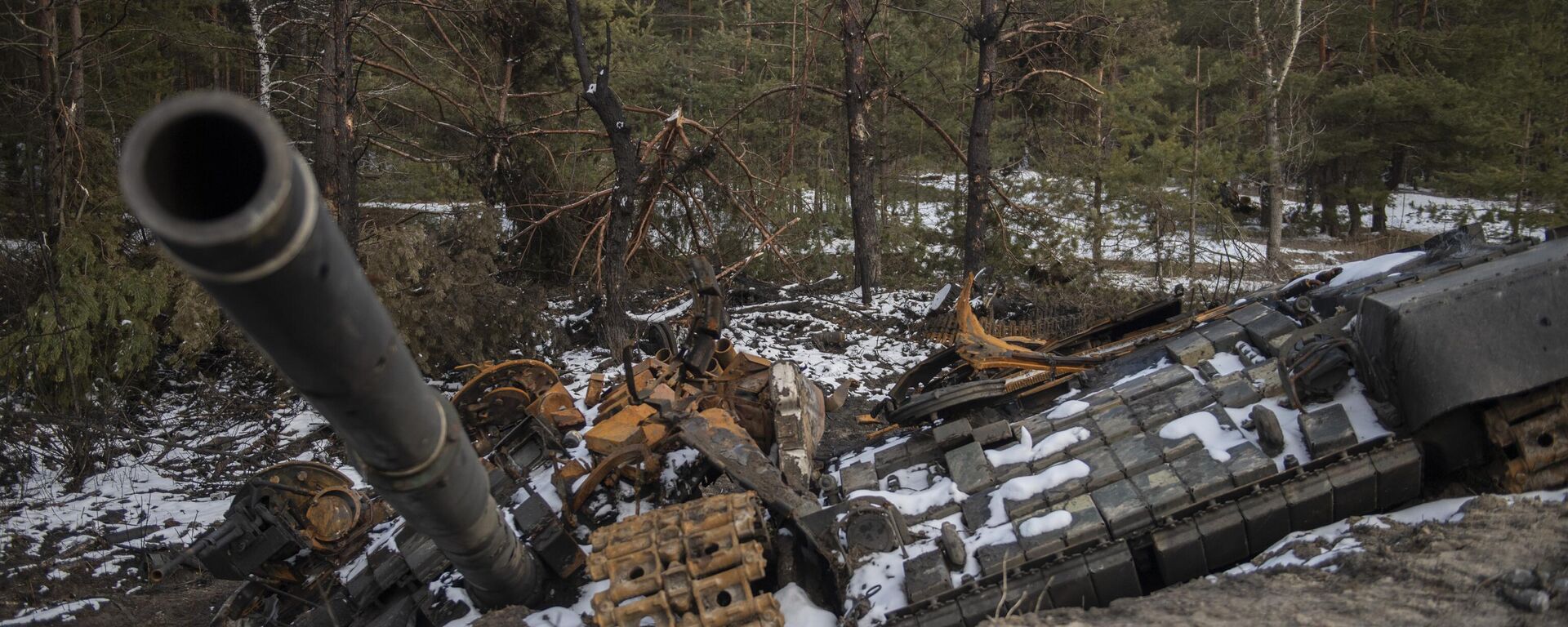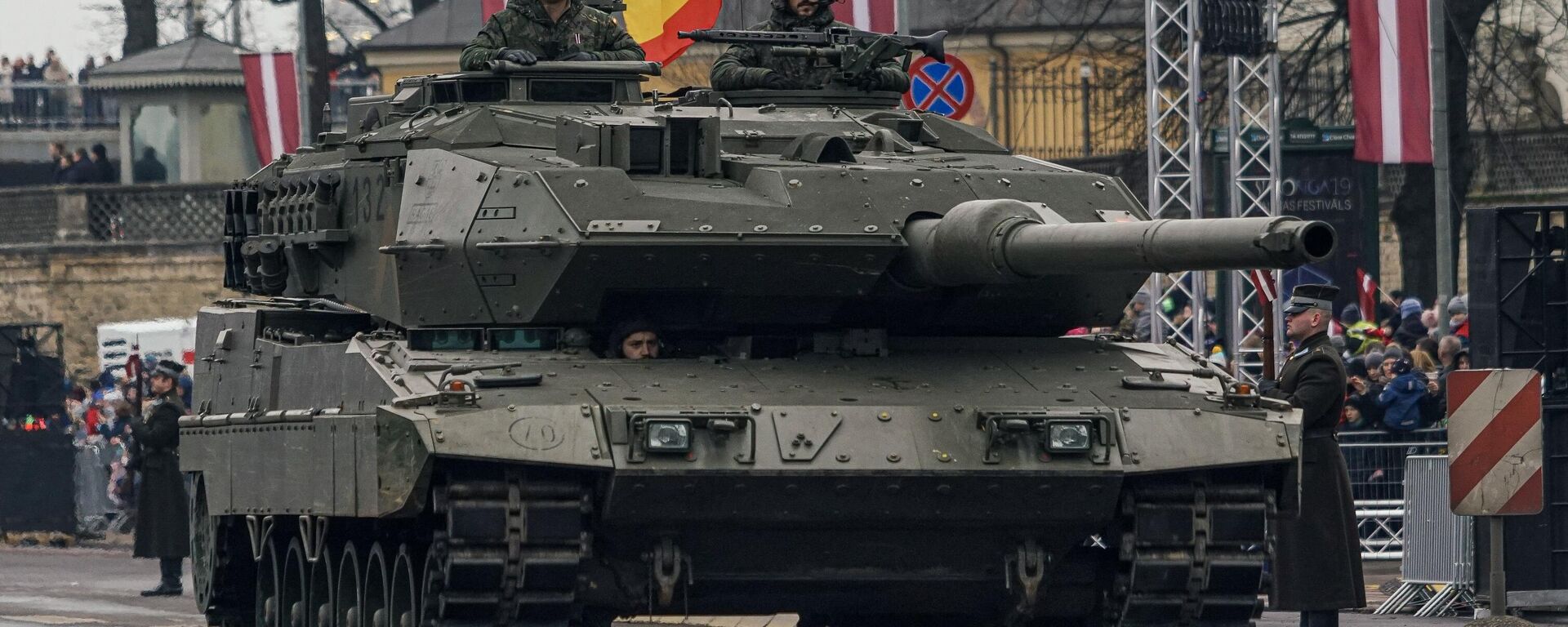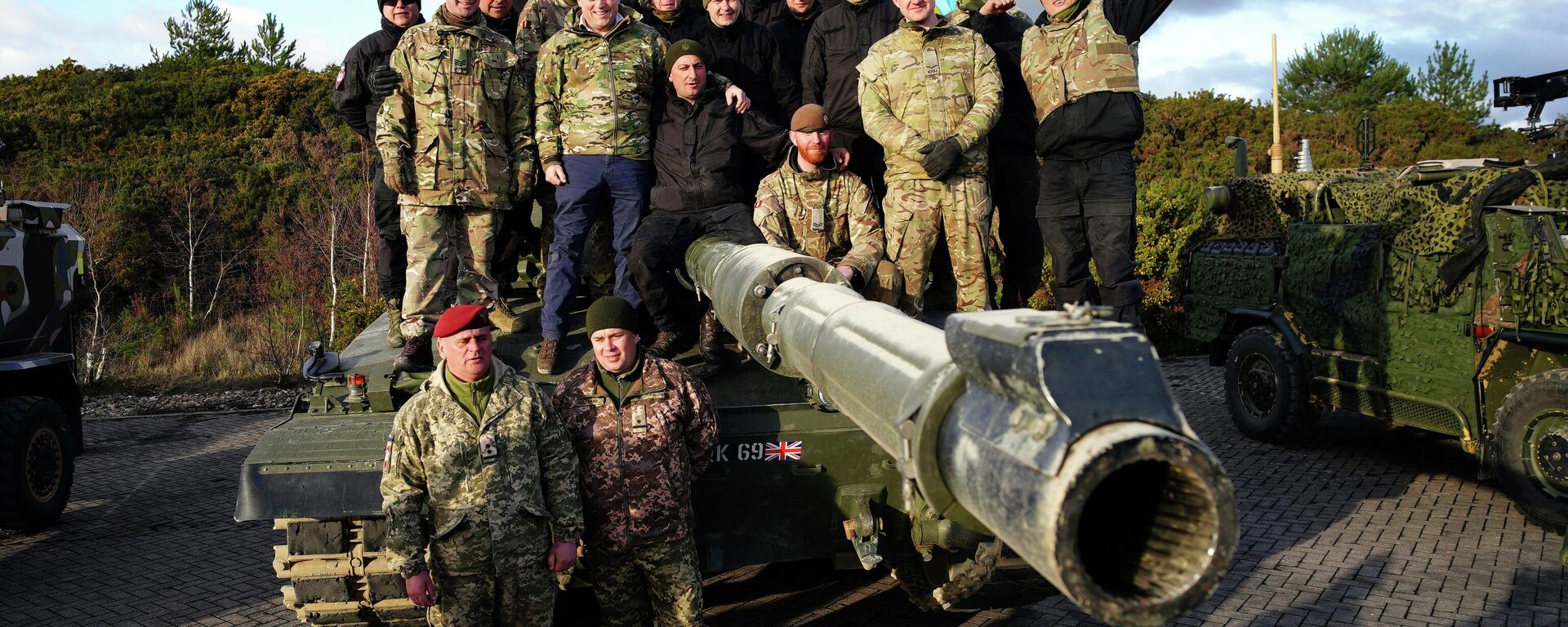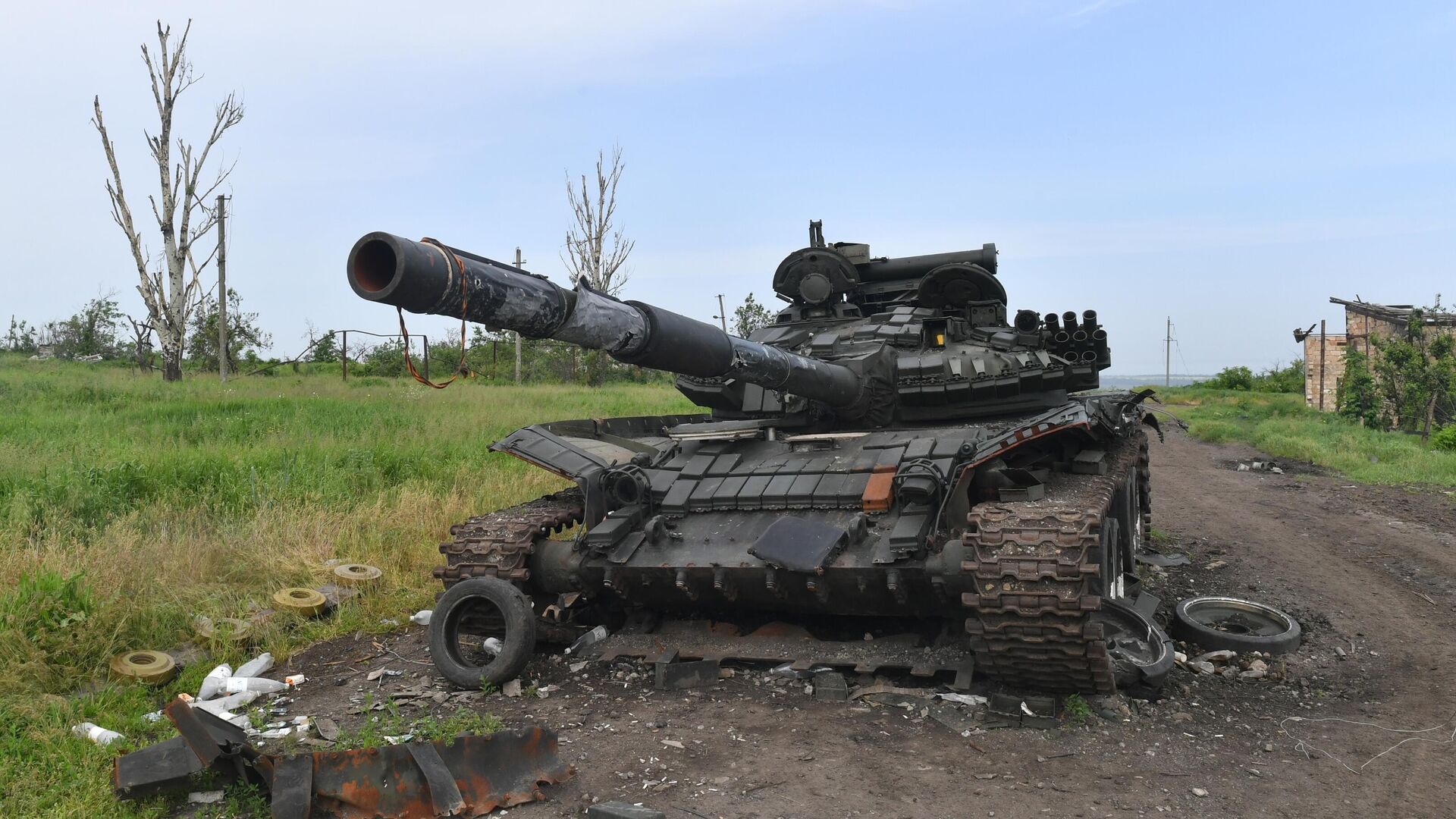https://sputnikglobe.com/20231002/which-countries-have-sent-tanks-to-ukraine-1113845971.html
Which Countries Have Sent Tanks to Ukraine?
Which Countries Have Sent Tanks to Ukraine?
Sputnik International
Initially, the tanks sent to Ukraine by its Western backers were mostly the Soviet models and their derivatives, which made sense from a number of perspectives. But Ukraine’s tank losses continued to mount and soon transports carrying bona fide Western tanks were seen heading to Ukraine.
2023-10-02T18:31+0000
2023-10-02T18:31+0000
2023-10-02T18:31+0000
ukraine
nato
leopard 2
t-72
m1 abrams tank
challenger 2
tanks
military
https://cdn1.img.sputnikglobe.com/img/07e7/08/1c/1112946220_0:62:3219:1873_1920x0_80_0_0_7736c4731df20862de8376babd0c6068.jpg
When the Ukrainian conflict escalated in 2022 and Kiev's forces found themselves at the forefront of NATO’s proxy war against Russia, the US and its European allies initially appeared content to provide limited military support while simultaneously trying to cripple Russia by harsh economic sanctions.As the economic warfare against Russia proved to be ineffective and Ukraine proved that it is quite adept at losing military hardware in combat but bad at replacing it, Kiev’s sponsors decided to switch gears and started to provide more and more potent weapons.Before February 2022, the US and its cohorts supplied Ukraine mostly with “defensive” weaponry such as Javelin portable anti-tank missile launchers. In 2022 and 2023, they provided Kiev with artillery, air defense systems and armored vehicles.While the nature of these contributions varied from country to country, a number of states even went as far as to supply Ukrainian forces with main battle tanks – the kind of weaponry that Kiev was supposed to use to smash through Russian defenses and bring its military to its knees, apparently.So which countries rushed to provide Kiev with these lumbering armored behemoths and what exactly did they send?Who Delivered Tanks to Ukraine?News about the Ukrainian military receiving tanks from NATO members started emerging as early as mid-2022, with donors being primarily the more recent additions to the bloc. NATO’s “founding fathers” appeared content at the time to just watch it all unfold.In July 2022, Ukrainian authorities proudly announced that they received a contingent of Polish PT-91 Twardy main battle tanks, which are essentially upgraded versions of the Soviet T-72 tanks Poland used to operate while being a member of the Warsaw Pact.The country also supplied Kiev with about 320 T-72 tanks.A number of different modifications of the T-72 were also sent to Ukraine by the Czech Republic, Bulgaria and North Macedonia, while Slovenia provided Kiev with M-55S tanks – a modification of an even older Soviet tank model, the T-55.Initially, the tanks sent to Ukraine by its Western backers were mostly the Soviet models and their derivatives, which made sense from a number of perspectives.For one, Ukrainian tank crews did not require extensive training to operate these vehicles, considering how they were similar to the tanks that the Ukrainian military already had, not to mention that repairing these tanks in situ was relatively easy. While Ukraine still had Soviet-era tanks it could cannibalize for parts and intact facilities where repairs could be carried out.But Ukraine’s tank losses continued to mount and soon transports carrying bona fide Western tanks were seen heading to Ukraine.Several NATO members – Germany, Spain, Canada, Denmark, Finland, the Netherlands, Poland (again), Spain and Portugal soon pledged to send Leopard 2 tanks to Ukraine.Denmark, Germany and the Netherlands also promised Kiev a large number of older Leopard 1 tanks, while Sweden brought Strv 122 – a Swedish version of the Leopard 2 – into the equation.Finally, the United States stepped in to deliver its famous M1 Abrams tanks to Ukraine, while Britain sent its Challenger 2 tanks.France also supplied Ukraine with a number of AMX-10RC armored vehicles, which are sometimes described as light tanks.Which Tanks Are Being Sent?Initial tank shipments to the Kiev regime mostly consisted of various modifications of the T-72 – probably one of the most ubiquitous main battle tanks in the world and, at one point, the mainstay of the Soviet tank forces.This 46-tonnes tank is actually lighter and more maneuverable than some of its more cumbersome counterparts from NATO countries; it has a diesel engine and is equipped with a 125mm smoothbore cannon.Weighing nearly 46 tonnes, the PT-91 Twardy is a Polish tank based on the Soviet T-72 design. This tank uses the same kind of 125mm gun as its Soviet-era predecessor, and features an upgraded engine, fire-control system and reactive armor.The German Leopard 2 tank, for comparison, weighs 67 tonnes, with its main weapon being a 120mm smoothbore cannon.Its predecessor, Leopard 1, weighs only about 42 tonnes (which is even slightly less than the weight of the T-72), armed with a 105mm cannon.Despite being subjected to a number of upgrades over the years, Leopard 1 is a fairly old tank that first entered service all the way back in 1965. Leopard 1 has long since been retired by Germany, although quite a few of these tanks are still being operated by countries in Europe and Latin America, not to mention the tanks donated to the regime in Kiev.The Stridsvagn 122, or Strv 122 for short, is essentially a Swedish modification of the Leopard 2 design. This 62-tonnes tank is armed with a 120mm smoothbore cannon and sports better armor and targeting systems than Leopard 2.While the Strv 122’s characteristics look very impressive, especially on paper, the fighting in Ukraine has already revealed that even such heavily protected tank can still be destroyed.Compared to the aforementioned tanks, the British Challenger 2 with its 75-tonne weight, looks like a lumbering armored behemoth sporting a 120mm rifled tank cannon. The UK Defense Ministry even used to boast on its website that no Challenger 2 has ever been lost to enemy fire - until September 2023 when it suddenly ceased being the case.The 67-tonne US M1 Abrams main battle tank is yet to make its debut on the battlefields of the Ukrainian conflict. The original versions of the M1 were armed with a 105mm rifled cannon while later modifications sport a 120mm smoothbore tank gun.One thing that sets the M1 Abrams apart from other tanks is its turbine engine that has worse fuel efficiency than, say, the engines of T-72 or Leopard 2.The 67-tonne US M1 Abrams main battle tank is yet to make its debut on the battlefields of the Ukrainian conflict. The original versions of the M1 were armed with a 105mm rifled cannon while later modifications sport a 120mm smoothbore tank gun.The M-55S is an upgraded version of the Soviet T-55 main battle tank, featuring a NATO-standard 105mm tank gun and improved targeting systems. The M-55S armor has also been beefed up and the tank also sports more advanced communication equipment than the T-55. All these improvements are practically a must, considering that the original T-55 entered service more than 70 years ago.The AMX-10RC, while armed with a 105mm gun, can barely be considered a light tank with its mass barely reaching 22 tonnes in the most heavily-laden version.This wheeled armored vehicle is quite mobile and nimble and packs a serious punch for its size, but its relatively thin armor essentially means that an AMX-10RC can dish out the pain but cannot take it itself.In one instance, a Ukrainian commander complained to media that one AMX-10RC operated by the Ukrainian Armed Forces was lost when an artillery shell exploded nearby and fragments from the shell penetrated the vehicle’s armor.
https://sputnikglobe.com/20230930/scott-ritter-abrams-tanks-will-become-mobile-steel-coffins-for-ukrainian-crews-1113821460.html
https://sputnikglobe.com/20230926/swiss-parliament-oks-decommissioning-25-leopard-2-tanks-to-sell-them-to-germany---reports-1113678347.html
https://sputnikglobe.com/20230905/uk-made-challenger-2-tank-got-first-taste-of-combat-in-ukraine---and-failed-1113138090.html
ukraine
Sputnik International
feedback@sputniknews.com
+74956456601
MIA „Rossiya Segodnya“
2023
News
en_EN
Sputnik International
feedback@sputniknews.com
+74956456601
MIA „Rossiya Segodnya“
Sputnik International
feedback@sputniknews.com
+74956456601
MIA „Rossiya Segodnya“
who delivered tanks to ukraine, what tanks are being sent to ukraine, military aid for ukraine, what tanks are coming to ukraine, are leopard 1 tanks going to ukraine, what tanks are being sent to ukraine by the us
who delivered tanks to ukraine, what tanks are being sent to ukraine, military aid for ukraine, what tanks are coming to ukraine, are leopard 1 tanks going to ukraine, what tanks are being sent to ukraine by the us
Which Countries Have Sent Tanks to Ukraine?
Over the course of the conflict, the United States and its NATO allies eagerly supplied the regime in Kiev with a variety of weapons and military equipment, ranging from small arms and body armor to multiple launch rocket systems and main battle tanks.
When the Ukrainian conflict escalated in 2022 and Kiev's forces found themselves at the forefront of NATO’s proxy war against Russia, the US and its European allies initially appeared content to provide limited military support while simultaneously trying to cripple Russia by harsh economic sanctions.
As the economic warfare against Russia proved to be ineffective and Ukraine proved that it is quite adept at losing military hardware in combat but bad at replacing it, Kiev’s sponsors decided to switch gears and started to provide more and more potent weapons.
Before February 2022, the US and its cohorts supplied Ukraine mostly with “defensive” weaponry such as Javelin portable anti-tank missile launchers. In 2022 and 2023, they provided Kiev with artillery, air defense systems and armored vehicles.
While the nature of these contributions varied from country to country, a number of states even went as far as to supply Ukrainian forces with
main battle tanks – the kind of weaponry that Kiev was supposed to use to smash through Russian defenses and bring its military to its knees, apparently.
So which countries rushed to provide Kiev with these lumbering armored behemoths and what exactly did they send?
Who Delivered Tanks to Ukraine?
News about the Ukrainian military receiving tanks from NATO members started emerging as early as mid-2022, with donors being primarily the more recent additions to the bloc. NATO’s “founding fathers” appeared content at the time to just watch it all unfold.
In July 2022, Ukrainian authorities proudly announced that they received a contingent of
Polish PT-91 Twardy main battle tanks, which are essentially upgraded versions of the Soviet T-72 tanks Poland used to operate while being a member of the Warsaw Pact.
The country also supplied Kiev with about 320 T-72 tanks.
A number of different modifications of the T-72 were also sent to Ukraine by the Czech Republic, Bulgaria and North Macedonia, while Slovenia provided Kiev with M-55S tanks – a modification of an even older Soviet tank model, the T-55.
Initially, the tanks sent to Ukraine by its Western backers were mostly the Soviet models and their derivatives, which made sense from a number of perspectives.
For one, Ukrainian tank crews did not require extensive training to operate these vehicles, considering how they were similar to the tanks that the Ukrainian military already had, not to mention that repairing these tanks in situ was relatively easy. While Ukraine still had Soviet-era tanks it could cannibalize for parts and intact facilities where repairs could be carried out.

30 September 2023, 13:00 GMT
But Ukraine’s
tank losses continued to mount and soon transports carrying bona fide Western tanks were seen heading to Ukraine.
Several NATO members –
Germany, Spain, Canada, Denmark, Finland, the Netherlands, Poland (again),
Spain and Portugal soon pledged to send
Leopard 2 tanks to Ukraine.
Denmark, Germany and the Netherlands also promised Kiev a large number of older Leopard 1 tanks, while Sweden brought Strv 122 – a Swedish version of the Leopard 2 – into the equation.
Finally, the
United States stepped in to deliver its famous
M1 Abrams tanks to Ukraine, while Britain sent its Challenger 2 tanks.
France also supplied Ukraine with a number of
AMX-10RC armored vehicles, which are sometimes described as light tanks.
Which Tanks Are Being Sent?
Initial tank shipments to the Kiev regime mostly consisted of various modifications of the T-72 – probably one of the most ubiquitous main battle tanks in the world and, at one point, the mainstay of the Soviet tank forces.
This 46-tonnes tank is actually lighter and more maneuverable than some of its more cumbersome counterparts from NATO countries; it has a diesel engine and is equipped with a 125mm smoothbore cannon.
Weighing nearly 46 tonnes, the PT-91 Twardy is a Polish tank based on the Soviet T-72 design. This tank uses the same kind of 125mm gun as its Soviet-era predecessor, and features an upgraded engine, fire-control system and reactive armor.
The German Leopard 2 tank, for comparison, weighs 67 tonnes, with its main weapon being a 120mm smoothbore cannon.

26 September 2023, 09:49 GMT
Its predecessor, Leopard 1, weighs only about 42 tonnes (which is even slightly less than the weight of the T-72), armed with a 105mm cannon.
Despite being subjected to a number of upgrades over the years, Leopard 1 is a fairly old tank that first entered service all the way back in 1965. Leopard 1 has long since been retired by Germany, although quite a few of these tanks are still being operated by countries in Europe and Latin America, not to mention the tanks donated to the regime in Kiev.
The Stridsvagn 122, or Strv 122 for short, is essentially a Swedish modification of the Leopard 2 design. This 62-tonnes tank is armed with a 120mm smoothbore cannon and sports better armor and targeting systems than Leopard 2.
While the Strv 122’s characteristics look very impressive, especially on paper, the fighting in Ukraine has already revealed that even such heavily protected tank can still be destroyed.
Compared to the aforementioned tanks, the British
Challenger 2 with its 75-tonne weight, looks like a lumbering armored behemoth sporting a 120mm rifled tank cannon. The UK Defense Ministry even used to boast on its website that no Challenger 2 has ever been lost to enemy fire - until September 2023 when it suddenly ceased being the case.
The 67-tonne US M1 Abrams main battle tank is yet to make its debut on the battlefields of the Ukrainian conflict. The original versions of the M1 were armed with a 105mm rifled cannon while later modifications sport a 120mm smoothbore tank gun.
One thing that sets the M1 Abrams apart from other tanks is its turbine engine that has worse fuel efficiency than, say, the engines of T-72 or Leopard 2.
The 67-tonne US M1 Abrams main battle tank is yet to make its debut on the battlefields of the Ukrainian conflict. The original versions of the M1 were armed with a 105mm rifled cannon while later modifications sport a 120mm smoothbore tank gun.

5 September 2023, 18:50 GMT
The M-55S is an upgraded version of the Soviet T-55 main battle tank, featuring a NATO-standard 105mm tank gun and improved targeting systems. The M-55S armor has also been beefed up and the tank also sports more advanced communication equipment than the T-55. All these improvements are practically a must, considering that the original T-55 entered service more than 70 years ago.
The AMX-10RC, while armed with a 105mm gun, can barely be considered a light tank with its mass barely reaching 22 tonnes in the most heavily-laden version.
This wheeled armored vehicle is quite mobile and nimble and packs a serious punch for its size, but its relatively thin armor essentially means that an AMX-10RC can dish out the pain but cannot take it itself.
In one instance, a Ukrainian commander complained to media that one AMX-10RC operated by the Ukrainian Armed Forces was lost when an artillery shell exploded nearby and fragments from the shell penetrated the vehicle’s armor.





